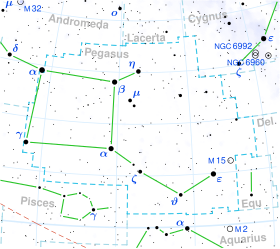Nu Pegasi
Star in the constellation Pegasus From Wikipedia, the free encyclopedia
ν Pegasi, Latinized as Nu Pegasi is a single[12] star in the northern constellation of Pegasus. It is an orange-hued star that is faintly visible to the naked eye with an apparent visual magnitude of 4.84.[2] The star is located approximately 261 light years away based on parallax,[7] but is drifting closer with a radial velocity of −19 km/s.[6]
| Observation data Epoch J2000 Equinox J2000 | |
|---|---|
| Constellation | Pegasus |
| Right ascension | 22h 05m 40.75170s[1] |
| Declination | 5° 03′ 30.7201″[1] |
| Apparent magnitude (V) | 4.84[2] |
| Characteristics | |
| Evolutionary stage | red giant branch[3] |
| Spectral type | K4III[4] |
| U−B color index | +1.80[2] |
| B−V color index | +1.44[2] |
| Variable type | suspected[5] |
| Astrometry | |
| Radial velocity (Rv) | −18.90[6] km/s |
| Proper motion (μ) | RA: +101.759[7] mas/yr Dec.: +100.923[7] mas/yr |
| Parallax (π) | 12.4810 ± 0.3322 mas[7] |
| Distance | 261 ± 7 ly (80 ± 2 pc) |
| Absolute magnitude (MV) | 0.26[8] |
| Details[9] | |
| Mass | 1.13 M☉ |
| Radius | 24.57 R☉ |
| Luminosity | 149 L☉ |
| Surface gravity (log g) | 1.72 cgs |
| Temperature | 4,073 K |
| Metallicity [Fe/H] | +0.02 dex |
| Rotational velocity (v sin i) | 2.3[10] km/s |
| Age | 8.1+2.3 −0.4[3] Gyr |
| Other designations | |
| Database references | |
| SIMBAD | data |
This is an aging giant star, most likely (94% chance) on the red giant branch,[3] with a stellar classification of K4III.[4] It is a suspected variable, with a magnitude range observed from 4.83 to 4.86.[5] With the supply of hydrogen at its core exhausted, the star has cooled and expanded to 24.6 times the Sun's radius. It is 13% more massive than the Sun and is radiating 149 times the Sun's luminosity from its swollen photosphere at an effective temperature of 4,073 K.[9]
References
Wikiwand - on
Seamless Wikipedia browsing. On steroids.

